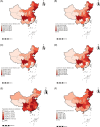Temporal trend and attributable risk factors of Alzheimer's disease and other dementias burden in China: Findings from the Global Burden of Disease Study 2021
- PMID: 39312279
- PMCID: PMC11567818
- DOI: 10.1002/alz.14254
Temporal trend and attributable risk factors of Alzheimer's disease and other dementias burden in China: Findings from the Global Burden of Disease Study 2021
Abstract
Introduction: We examined the burden of Alzheimer's disease and other dementias (ADOD) and attributable factors at the national and provincial levels in China.
Methods: Using the Global Burden of Diseases Study 2021, we estimated incidence, prevalence, mortality rate, disability-adjusted life years (DALYs), and the ratio of years lived with disability (YLD) to DALYs for ADOD in China. Estimated annual percentage changes (EAPCs) were used to quantify the temporal trends from 1990 to 2021.
Results: In 2021, China experienced the highest ADOD burden among Group of 20 member nations. The EAPCs for age-standardized rates for incidence, age-standardized rates for prevalence, and age-standardized mortality rate were 0.41 (uncertainty intervals [UIs] 0.34-0.49); 0.44 (UI: 0.36-0.52); and -0.19 (UI: -0.23 to -0.15), respectively. Between 1990 and 2021, the number of people with ADOD increased by 322.18% and DALYs associated with ADOD increased by 272.71%; most of these increases were explained by population aging.
Discussion: Considering the aging Chinese population, targeted strategies to prevent dementia are urgently needed.
Highlights: China experienced the highest dementia burden among Group of 20 member nations. High body mass index, high fasting plasma glucose, and smoking were major risk factors for Alzheimer's disease and other dementias (ADOD) burden. Since 1990, the incidence and prevalence of ADOD increased substantially in China. The mortality rate related to ADOD decreased consistently. Considering the aging Chinese population, targeted strategies are urgently needed.
Keywords: Alzheimer's disease and other dementias; Global Burden of Diseases Study; disability‐adjusted life years; incidence; mortality; prevalence.
© 2024 The Author(s). Alzheimer's & Dementia published by Wiley Periodicals LLC on behalf of Alzheimer's Association.
Conflict of interest statement
All authors have no actual or potential competing interests to declare. Author disclosures are available in the supporting information.
Figures




References
-
- Jia L, Quan M, Fu Y, et al. Dementia in China: epidemiology, clinical management, and research advances. Lancet Neurol. 2020;19:81‐92. - PubMed
-
- Zheng Z. From the past to the future: what we learn from China's 2020 Census. China Popul Dev Stud. 2021;5:101‐106.
MeSH terms
Grants and funding
LinkOut - more resources
Full Text Sources
Medical

